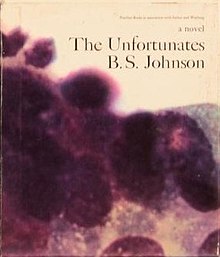The Unfortunates
 First UK edition | |
| Author | B. S. Johnson |
|---|---|
| Language | English |
| Genre | Ergodic |
| Publisher | Panther Books (UK) Secker & Warburg (US) |
Publication date | 1969 |
| Publication place | United Kingdom |
| Media type | Paperback (27 unbound sections in laminated box) |
| Pages | 244 pages |
| OCLC | 40588291 |
The Unfortunates is an experimental "book in a box" published in 1969 by English author B. S. Johnson and reissued in 2008 by New Directions.[1] The 27 sections are unbound, with a first and last chapter specified: the 25 sections between them, ranging from a single paragraph to 12 pages in length, are designed to be read in any order,[1] giving a total of 15.5 septillion possible combinations that the story can be read in.[2] Christopher Fowler described it as "a fairly straightforward meditation on death and friendship, told through memories."[3] Jonathan Coe described it as "one of the lost masterpieces of the sixties".[4]
BBC producer Lorna Pegram employed Johnson to talk about this creation for the TV series "Release" after she was lobbied by Carmen Callil of Panther books. With barely any negotiation the interview was ready months before the book was ready for publication. The film included Johnson holding a mock-up of the book that was not at all similar to the final publication.[5]
Johnson said of the book "I did not think then, and do not think now, that this solved the problem completely… But I continue to believe that my solution was nearer; and even if it was only marginally nearer, then it was still a better solution to the problem of conveying the mind’s randomness than the imposed order of a bound book."[6][7]
Plot
[edit]A sportswriter is sent to a city (identifiable through landmarks as Nottingham) on an assignment, only to find himself confronted by ghosts from his past. As he attempts to report on a football match, memories of his friend, a victim of cancer, haunt his mind.
The city visited remains unnamed, however the novel contains an accurate description of Nottingham landmarks, its streetscape, and its environment in 1969, with additional recallings of 1959. The football ground in the novel is Nottingham Forest's City Ground.
References
[edit]- ^ a b Charles Taylor (22 August 2008). "Piece This One Together". The New York Times.
- ^ Hooper, Mark (14 October 2014). "Why BS Johnson suits the digital age". The Guardian. ISSN 0261-3077. Retrieved 1 March 2019.
- ^ Christopher Fowler (18 October 2009). "Forgotten authors No.40: BS Johnson". The Independent. Archived from the original on 20 June 2022.
- ^ Jonathan Coe (28 May 1997). "I wish I'd written". The Guardian.
- ^ Coe, Jonathan (2005). Like a Fiery Elephant: The Story of B. S. Johnson. Pan Macmillan. p. 257. ISBN 978-0-330-35049-5.
- ^ "Introduction". Aren't You Rather Young to be Writing Your Memoirs?. Hutchinson. 1973. ISBN 978-0091181413.
- ^ Jonathan Coe (17 October 2002). "Death by Naturalism". Jonathan Coe.
External links
[edit]- New Directions Publishing
- Éva Zsizsmann (2005). "Mapping Memory in B. S. Johnson's The Unfortunates" (PDF). Theory and Practice in English Studies 4: Proceedings from the Eighth Conference of British, American and Canadian Studies. 4. ISSN 1805-0859.
- Henry Hitchings (8 November 1999). "Back in print: The Unfortunates". New Statesman.
- Chris Bench. "B. S. Johnson, The Unfortunates. New York: New Directions, 2009" (PDF). Chicago Review. 55 (3–4): 230–233.
